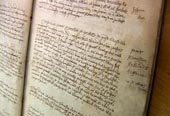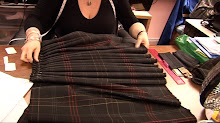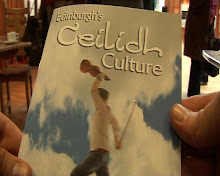Friday 21st March 2008
In this week's Newsletter: KILTS, SCOTTISH PRODUCE, FAMILY HISTORY , CASTLES.
Spring has officially sprung here in Scotland. Wednesday was the first day of spring, so, despite forecasts of snow for the Easter weekend ahead, we're celebrating the sunshine, spring flowers and lighter evenings.
We've been out and about looking for signs of new life in preparation for this Easter weekend in Glasgow. In Pollok Park on the Southside, the visiting baby animals are the star attraction, but Easter wouldn't be complete without eggs, so it's time to get creative with decorative paint too. The buds are on the trees in Glasgow's leafy West End, and the Botanic gardens is awash with the colour of daffodils, crocuses and blossoms - a promise of warmer days to come! A snapshot of spring in and around Glasgow can be found here.
So what better time to have a spring clean of our weekly newsletter. This is the new-look mailing. The links work in exactly the same way as the old one - just click onto the headers or images below. We hope you like it.
Happy Easter!
The Evolution of the Kilt
Geoffrey (Tailor) Kiltmakers. Howie Nicholsby explains how the kilt takes shape at the Edinburgh Old Town Weaving Company where, in the workshop, a small but industrious team of skilled kiltmakers hand-crafts every order. As Howie discusses, there is no substitute for good quality - a woollen kilt handcrafted in Scotland is the real McCoy and worth the investment as it will last a lifetime. Discussing the evolution of the kilt through the Geoffrey (Tailor) dynasty, Howie explains that times are changing in the industry, but his family's business are doing all they can to preserve this Scottish icon - from pushing for a recognised qualification to train kiltmakers, to working with the Scottish Government on a PGI - Protective Geographical Indicator - that will protect the 'Scottish' kilt in the future.
The First Minister Eats Scottish
First Minister, Alex Salmond, gives the five thirty show's Eat Scottish campaign a boost by pledging to eat only Scottish produce for a week. How will he fare during the many functions he attends? And - more importantly - will he manage a week without his favourite curry?
Discover Your Ancestors
With Glasgow's Mitchell Library. Dr Irene O'Brien, senior archivist at the Mitchell Library, shows us what she believes is the best resource for family historians held at the Mitchell Library: The Poor Law Archives. These are applications for poor relief made by residents of Glasgow and the West of Scotland during the 19th and 20th Century. The Glasgow City Archives and Special Collections at the Mitchell library holds more than 1 million of these applications. The Poor Law Archives provide unique information about the applicants, their families and their life, and can be an interesting and valuable source of information for the family historian. Usually, an application for relief contains detailed records of name, age, birthplace, marital status, religion, occupation, earnings, children, siblings and parents. Moreover, it also compiles detailed notes about the applicant and can even contain letters, certificates, newspapers cuttings and pictures, used by the poor law authorities to investigate each applicant. In part 5 of our series, Dr O'Brien reveals an example of a fraudulent poor law application that was investigated and solved by the authorities. The letters and notes contained in the application help to put together all the pieces of this dramatic puzzle.
Castles of Scotland: Fort George
From the stv archive this week, we have an episode from Castles of Scotland featuring the extraordinary Fort George.
Strategically situated on an isolated spit of land at Ardersier, near Inverness, Fort George was built by George II, following the 1746 Battle of Culloden. The Fort was designed to solve the threat posed by the possibility of further attacks from the Jacobites, and is still one of the most extensive artillery fortifications in Europe. This feature offers an historical tour through the Fort and its buildings, as well as an insight to the barracks built to accommodate more than a thousand soldiers.
Scottish RNLI Lifeboat
appears on a First Class Stamp. The heroics of a Scottish Western Isles RNLI Lifeboat crew have been immortalised on a new 1st class stamp. The Royal Mail has produced the stamp to recognise the heroics of the 28 men and women who make up the RNLI team in Barra and regularly risk their own lives to save others.
The stamp is one of six which make up the commemorative set which show actual rescues and training exercises from the Royal National Lifeboat Institution and the Maritime and Coastguard Agency. Since the island station in Barra opened in 1931, there have been more than 500 launches, and 412 lives have been saved.
Politics Now
Thursday 20th March 2008. Michael Crow presents stv's weekly look at Scottish politics. This week's guests in the studio are Wendy Alexander MSP, Lord O'Neill of Clackmannan, Colin Mackay and Denis R Sullivan.
Scottish Recipe: Herring
Scottish chef, John Quigley gives an oriental twist to one of Scotland's most historic fish - the herring. This week we have a healthy and creative recipe taken from stv's popular series Room at the Top. Nicknamed 'the silver darling', the herring provides an economic and nutritious source of food, and has been very important to the Scottish diet for many years. Being one of the most abundant fishes in the seas around Scotland, it also played a major part in developing a successful Scottish herring industry. The Scottish herring fishery has exported this fish all over the world for hundreds of years and even became, in the later 19th and early 20th century, one of the biggest fisheries in the world. Here, John Quigley uses fresh herring fillets to prepare a variation of a classic Rollmop with a nice oriental touch, and some sweet soy sauce cured herring.
To watch the video, click here. To read the written recipe, click here.
Alex Salmond Unveils Tartan Day Plans
The First Minister was at St Andrews this week, to unveil plans to sell Scotland to the United States and Canada. Alex Salmond was launching the programme for this year's Tartan Day and Scotland Week, which he said would showcase the country on the world stage. Later this month, events will take place across seven cities in North America, aimed at highlighting Scotland as a dynamic market with great investment potential. Mr Salmond said: "We're launching Scotland Week and Tartan Day. So we're trying to connect up the Tartan Celebrations, which are great, with the promotion of Scotland and that means the promotion of Scottish business, Scottish academia, the Homecoming Year next year, and Scottish culture. "These are all things which have a real resonance. We have to make sure we connect the celebration aspect with the hard nosed business aspect. We're trying to generate some business and jobs for our economy and that's what we're doing in an ambitious and cost effective programme next month."
Subscribe to:
Post Comments (Atom)

























No comments:
Post a Comment